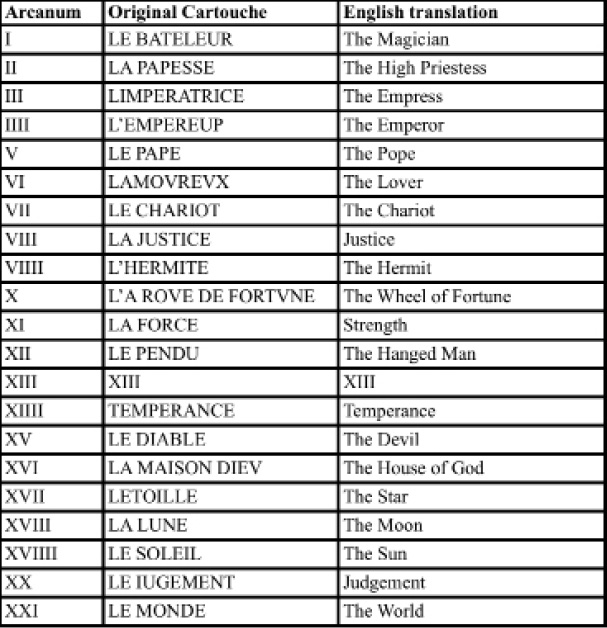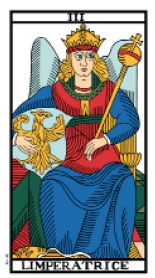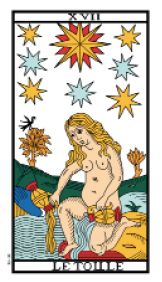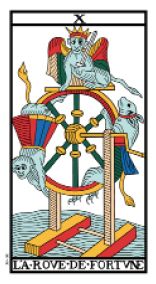4.2 The Coded Structure: New Codes
It seems a good idea to pause for reflection on what has been said up until now. All of the knowledge enclosed in the Tarot over the course of the centuries, has been totally disintegrated, losing itself in a multitude of different games containing only a part of the original symbolism. Although the antique deck of Conver, custodian of the Tradition, conserved the symbols and significance thanks to the presence of the Coded Structure , we are speaking in any case of images. How then may the sense of these be comprehended through observation? What does it mean, to develop the aforementioned attitude of a child? The key is simplicity . Let us imagine that all the acquired mathematical knowledge of man were to disappear. How to reconstruct it? We would need to begin again with primary questions, basic principles. With time, an elaborate science, whose foundations rest however upon elementary notions, would form anew. It is the same for the Tarot. Let us immerse ourselves in a distant epoch, the Middle Ages, for example, in a time with no modern comforts such as television or internet. We meet a monk who gives us this deck of cards. How may we, without outside help, enter into the secrets of these Icons? Let us begin to observe them, perhaps even unable to read the names of the cards, whose meanings, given the immediacy of the images, we would learn intuitively. Our sole possibility would be to begin to understand the simplest things: which figures are of men, which of women; who is dressed, who nude; which bizarre figures are described, and so on. We would not wonder right away about the symbolical and occult content, also because we might not have the capacity. All that would be secondary. In any case, thanks to the first data suggested by observation of the illustrations, we would perhaps gradually begin to comprehend certain connections, first in a rudimental manner and then more and more clearly…until we discover the presence of hidden coded messages. In this manner, as demonstrated by the comparison Hanged Man-World, we realize that the Codes necessitate a particular mode of comparing symbols and concepts, a modality of thought and a form of association to which we are not accustomed.
To analyze the Tarot through this form of association based upon simplicity, reawakens partially sleeping functions and generates in us new mental abilities. We undergo the procedures of the Science of Signs , the dynamic that stimulates the capacity of comprehension of particular connections in the events of the exterior world with which we interact. The Codes are hidden and with the gradual development of this aptitude, called the module of Synchronicity , we begin to observe and comprehend them more fully. At the same time, thanks to this practice, we observe ever more evident relationships between daily occurrences, as we undergo an expansion of our capacity to recognize those happenings which are called coincidences but which would more accurately be termed synchronicities. Attention, however: this does not mean that we are free to make subjective deductions (not for the Tarot, nor for events), as the principles of decoding are subject to iron laws: The Code, in fact, is a mode of expression characterized by iconic objectivity, bearing a precise message, part of a coherent and harmonious teaching .
There is no space for fanciful hypotheses, as to enter into the codified framework means to penetrate with rigor, precision and accuracy into a Science. In the process of study of the Codes, 3 steps must be followed in order:
1) observation of their existence
2) comprehension of their functioning
3) extraction of a true esoterical teaching.
For this reason, it may be more profitable, at least in the beginning, to entrust oneself to an instructor of Tarot, who is able to furnish the instruments necessary for entering the universe of Codes. In this way, the requisites for awakening the qualities needed, and an autonomous discernment of the subject, are created in them. In fact, if not correctly introduced to the subject, it is not easy to take the first steps, whose precise individuation completely changes one’s approach. The Codes, all connected among themselves, are thousands. To comprehend them, it is indispensable to follow a definite order and above all to pursue an authentic search in our daily lives, for honesty and truth, to return to the purity of a child. For those who proceed without these prerequisites, the access to the Coded Structure and to the dimension to which it leads, is limited or even forbidden, it being a world which opens the doors not only to Synchronicity but also t o Intuition, to and to the comprehension of certain Laws which govern the events of destiny , treasures that may be received only by those who are prepared. To comprehend this dimension of comparison, its meaning and to which benefits it may lead, will be of great help to us in the next comparison we face.
Let us look again at the 3x7 Diagram and dedicate ourselves to the study of the Arcana of the Lover and of Judgement. Although the comparison may be easier, it would be well not to let ourselves be fooled by the apparent facility of the results produced by the discovery of the first Codes. Without a vaster comprehension of the Coded Structure and without other keys of decryption, we may easily remain excluded from this sort of sacred edifice, from this enormous Cathedral that goes by the name of Tarot. In this initial phase, in which the capacity of observation is still maturing, to be able to see all the connections is relatively difficult.

Fig. 11
The Lover - Judgement
At first glance, we note a similar scheme: three small subjects in the lower part of the card and an angel in the sky in the upper part. We find this analogy in other particulars as well. Behind the angel of the Lover, for example, there are yellow and red rays; also, with different lengths, behind the angel of Judgement. In the VI, there are at least two figures in relationship with each other, as in the XX with two subjects in prayer before a celestial being. There is the concept of “couple”. The list could be longer, but despite complexity and indubitable analogy, we note that a series of details is in antithesis. In VI, for example, the couple is younger and dressed, while in XX the figures are nude and older, emphasized even more by the presence of the one risen from the dead is testimony to the maximum possible achievement of goals in the course of a life with respect to the number of its years. Furthermore, to the nude infant angel corresponds the dressed adult angel and this opposition, which appears also in the area of the same card, not only confirms the different ages of the human subjects, but generates a double inversion. Dualism codified through these messages is obvious, and is proven by another aspect as well: in the VI Arcanum the humans are larger than the angel is, they appear more important, while in the XX the reverse is true. A precise continuity is revealed, as the Lover belongs to the bottom row and to the lower part of the sixth column of the Diagram, both facts recalling the Earth, while Judgement is in the top row and the high part of the vertical, therefore in the Heavens. Here is, once again, the terrestrial-celestial duality. Let us sum up briefly what we have learned:
Analogies:
3 Personages + 1 Angel ←→ 3 Personages + 1 Angel (analogy)
Yellow and red rays ←→ Yellow and red rays (analogy)
Couple ←→ Couple
Antitheses:
3 Dressed personages + 1 nude Angel ←→ 3 Nude personages + 1 dressed Angel
Dressed personages-nude Angel ←→ Nude personages-dressed Angel
Young couple ←→ Elderly couple
Young Angel ←→ Adult Angel
3
Large personages + 1 Small Angel
←→
3
Small personages + 1 Large Angel
This allows us to take note of two basic points:
1) the preceding mechanism of antithesis/inversion appears as a regular dynamic;
2) the analogy is intended as a new codifying mechanism.
In order to evaluate the teaching brought forward by this confrontation/comparison, let us continue with an in-depth analysis of the theme of the couple.

Fig. 12
Expansion of consciousness
In Judgement, the nudity and the act of devotion itself clearly suggest a more evolved relationship with respect to the Lover. The hands, for example, in sharp contrast with those of the lower row, no longer touch. In VI, in fact, the humans have more carnal and terrestrial desires and seek principally physical contact and conversation. No one looks up to interact with the angel, representing the celestial sphere, who therefore in order to be able to give counsel, is forced to shoot arrows. These, which flying through the air represent the mental planes, portray thoughts and intuitions sent to allow the spiritual world to manifest upon the earth. Gradually, after a painful transformation in which we “lose some pieces of personality”, as suggests the Arcanum XIII at the middle of the sixth column, in the XX card, men reach a higher evolution. Here, represented nude and without the lower part of the body, connected to more instinctive desires, not only are they in prayer, but also listen to (from the trumpet) and see (from the direction of the bearded man’s head) the celestial messenger.
The elegance of this Code emphasises that the protagonists of the Lover are in a condition of ordinary consciousness while those of judgement are in a state of superior knowledge and perception, similar to that of mediums, prophets and those who transform internally. Not all of these relationships can be casual and there are sufficient elements to ascertain that, as for the Hanged Man-World couple, also for the Lover-Judgement couple, the codification is intentional. Furthermore, here as well we have developed multiple planes. The generally similar scheme (3+1) of the two cards represents Level 1, which allows the formation of a more immediate initial comprehension, a “grasp” of the Code. The presence of a Dualism expressed in diverse modalities of antithesis, is Level 2; the individuation of a couple, young and old, is a new level in itself (3), as it may suggest teaching of the couple, but also a demonstration of the different degrees of consciousness to which it is possible to elevate oneself (4). For now, we will limit ourselves to a general evaluation in order to avoid excessive complexity. Our objective is of an informative nature, to make known to the general public the existence of the various functioning mechanisms of the Tarot. First, it is necessary to understand well the anatomy and physiology of the Codes, how they are made and how they work, to be able to aspire to a successive phase, which leads towards the metaphysical teaching they bear. As all follows a rhythm of learning, let us be content for now with metabolizing that which has been presented and let us continue in another direction, introducing those that are called “text-Codes.”
We have already mentioned the existence of the text-Codes, the puzzles present in the cartouches of the cards. Although the names of the Tarot in the present (translated) work are in English (in the original, in Italian), their original forms were in a somewhat atypical French. As the original cartouches are the only ones to contain Codes, our own choice of names is merely practical. Thus, since in translation all is lost, it is indispensable to submit a comparative table, as below, to show the correct nomenclature:

Some important details cannot be missed. For example, if the Tarot was created in the first centuries A.D., how is it possible that, in that epoch, the names were written in this manner? For this more-than-legitimate question, there is a precise answer. In the first version of the Icons, the cartouches were printed in post-Latin French. French belongs to the Romance language of the Indo-European family, and is a result of the contaminations that Vulgar Latin underwent in Rome-occupied Gaul, above all from the V century. In fact, the influence of the pre-existing local idioms of the Celts and the Franks, originated these languages (called romanes , or Romance) that later became d’oïl e d’oc , this last typical of the southern regions. Over the centuries, around the year 1000, the names of the Tarot were rewritten to adapt them to the times, and the first, Franco-Latin version was modified. For this task, the rigorous criteria of respecting all text-Codes and their inter-relations with the graphic-Codes, was followed. Although at this level it is not easy to comprehend, it was truly a mammoth work, which we cannot do other than describe with several examples.
Let us observe the cards along the third column of the 3x7 Diagram. In the cartouches of LIMPERATRICE and LETOILLE an apostrophe is lacking, while in L’A ROVE DE FORTVNE, there is one too many.

They are not errors or misprints, as we might believe, but Codes. In the cartouche LIMPERATRICE, for example, thanks to the lack of an apostrophe, we have the French verb LIMPER which corresponds to the Latin limpido (in French limpide), clean, pure. In this way LIMPERATRICE becomes “she who is pure”. The idea that the Arcanum corresponds to “She who purifies” is attested to also by the presence of an inlaid receptacle for holy water in her throne, a known symbol of catharsis. Thus, the characteristic of purification is an essential aspect for understanding the general sense of the card.

Fig. 13
Limperatrice (The Empress)
In LETOILLE, apart from the question of the apostrophe, there is another anomaly, which we must investigate: the double presence of the letter L. First, the lack of elision of the vowel creates the definite article LE. At the same time, the curious underscore uniting the letters I and the first L forms the letter U, which generates the word TOULE (French root meaning “source”) and which leads back to TULE. Finally, the close analogy between these two letters, which in the deliberately imprecise calligraphy may seem two I’s or two L’s, according to one’s analysis perspective, causes the word ILE ( ile , island) to appear. To sum up, we find the hidden expression “LE TOULE ILE” , the Isle of the Source/Font or the Isle of Tule/Thule, the legendary island at land’s end.

Fig. 14
Letoille (the Star)
In L’A ROVE DE FORTVNE, the extra apostrophe suggests that the accent is intentionally placed over the letter A, or Alpha. This deduction would be confirmed by the fact that the great wheel, the principal symbol of the card, with its round form expresses the letter O, or Omega. In symbolism in general, but in the Christian in particular, 68 the Alpha and the Omega, the first and last letters of the Greek alphabet, are the symbols of eternity and cyclicity, the beginning and the end of every principle. Considering the iconography of the Arcanum, it should not be difficult to accept the presence of this Code, found also, moreover, in many other points of the Coded Structure .

Fig. 15
L’a Rove de Fortvne (the Wheel of Fortune)
These text-Codes have not been developed in their entire potential. Although the current intent is simply to make their presence known, with an eye to consolidating the Coded Structure in the cartouches as well, we must report some other “anomalies:”
LAMOVREVX instead of L’AMOUREUX
L’HERMITE instead of L’ERMITE
LA MAISON DIEV instead of LA MAISON DIEU
LE IUGEMENT instead of LE JUGEMENT.
We need only indicate their existence in order to comprehend that they are not errors but voluntary messages. The choice of limiting comment derives from the impossibility of exhaustive explanation without greater explanation of other, closely interdependent, graphic-Codes.